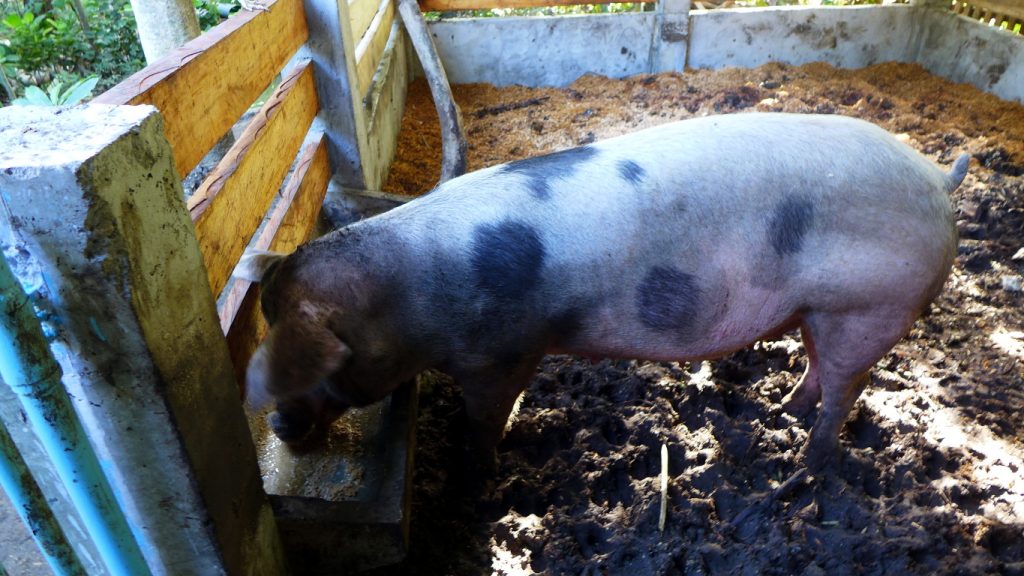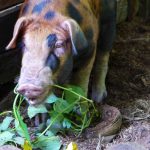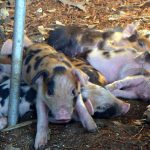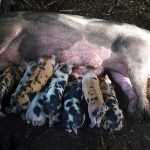Having ponds for rainwater harvesting, lots of frogs and toads are attracted to the garden. This is good because frogs are a sign of good ecology and they keep pesty insects under control. Here is a video of frogs spawning, one female and two males! The white foam is a nest in which the eggs are deposited. The foam nest protects the eggs from microbes and predators, to some extent – I have seen the turtle in the duck pond eating the frog eggs!
Rainwater Harvesting
If you look around the village you will still see old water cisterns built many decades ago before running water became available in households. Some of these have been abandoned, broken but a few are still in good use. Rainwater harvesting is particularly crucial if you have livestock, crops and drought seasons, as well as failures by the municipal waterworks to provide continuous running water.

Currently, we have three ponds that harvest rainwater. The first (photo above) is home to some 30-40 tilapia and floating water plants. It is located next to the house on the south side catching a good amount of rainwater flowing off the edge of the roof. It’s about 146 cubic feet (or about 4 cubic meters). I keep two buckets under the overflow pipe to collect more rainwater during an overflow.

The second (photo above) is located on the north side of the house and has a volume of about 70 cubic feet (or 2 cubic meters). This is home to water hyacinth, water lettuce and frogs. We didn’t put fish in this pond because the fish kills the water hyacinth and water lettuce. The presence of frogs and tadpoles make sure there are no mosquito larvae in this pond. The water in this pond is used as drinking water for sow Number 3 who also loves eating the water lettuce.

The third water reservoir is this (photo above), the duck pond. Some water lettuce thrive here but not the water hyacinths which the ducks eat immediately. This pond becomes dirty (build up of mud, organic material, algal blooms) when the duck population is high – that is, over a dozen ducks. This pond is not large enough for that many ducks. At the moment, I have only 8 ducks and it is the rainy season so the pond stays reasonably clean. The water plants also keep the water clean, preventing algal blooms. There are also 2 turtles in this pond, plus an impressive chorus of frogs and toads. These and the ducks ensure that mosquitoes do not thrive in this pond.

Rainwater from the first two ponds have been crucial during the Bohol (2013) and Leyte (2017) earthquakes which knocked down power supply to the island for several weeks. Without power, municipal water pumps are non-operational and cannot pump water to many households. We were able to use water harvested in these ponds for cleaning, for the animals to drink and for flushing.
Now we are seriously considering building another pond to harvest rainwater run-off from the roof of the new pigpens. This pond would be closer to the pigpens and would ease use. A rain garden nearby, where the ground slopes, might also be an excellent feature to catch water that overflows from the pond.

Cicada
A Better Pig Accommodation
Two months ago, I finally got one of the pigpens rebuilt. It is Sow Number 3’s pen. I wanted better accommodation for her when she farrows around the last week of August. The old pigpen has a leaky nipa roof and the fences and door serve as aperitif for Number 3. Several times Number 3 escaped from her old pen and terrorized the village. 😉

I came up with the design of the new pigpen based on observations and interactions with Number 3, studying pigpen housing standards and designs on the Internet and discussing the design plans with Trevor and the carpenters Kelly and Jessie.

The real test of the new design will be when Number 3 farrows. We will put the metal barrier and light for the piglet creep space into the pen soon. The pigpen has a total area of about 25 square meters, a comfortable space for one pig. My ideal is a large pasturing area, but we don’t have that much space. This is the best we can do!
The new pigpen allows more air and sunshine with a higher roof. It is certainly more durable than the old pen which was built using bamboo and wood. Such a pen is fine if we were keeping a pig for fattening, but a sow is a strong and powerful animal weighing up to 150 kilograms.
There will be two more large pens to be re-designed and built (for Sow Auntie Brownie and Pinky Boar) and two smaller pens for fattening a pig or two. The old pens are still usable but they are falling part and require much maintenance. I am hoping construction will be push through in September. The new farrowing unit will include an escape hatch for piglets (so they can enjoy the garden while they are up to 3 weeks old and give their mother a chance to relax).
Later, Trevor and I will look into developing the gardens (and possibly a pond or rain garden) around the pigpens so the area will be cooler, more productive and provide forage for the pigs.



First Farrowing for 2017
This is our first farrowing for 2017, also Auntie Brownie’s first parity. She is probably considered a late bloomer (at 2 years of age). The boar is a year younger, Brownie Boar (born and raised here as well). We decided on selective in-breeding, pigs are aunt/nephew relations. I was quite nervous about this but genetics of both pigs are very good so it was worth the try.
Auntie Brownie gave birth to 11 piglets. A 12th piglet – the last – was born dead. We decided on a no-intervention policy during farrowing. She started nest building at around midnight then farrowed at 8AM until 9AM. I watched her farrow from a distance.
On the fourth day after farrowing, we had to go to the city for our weekly shopping and left the sow and piglets to a caretaker – with bad results. When we returned in the afternoon, the sow was stressed and kept crushing her piglets. The next day, one piglet died of crushing. Another piglet was found dead after 2 days apparently from crushing as well. The caretaker had stressed the sow by going into the pen and making a lot of noise and fuss. Because of this experience, we decided not to leave the sow and piglets to other people even for just a second – at least until the piglets are strong enough not to be crushed – about 4 weeks old.
The piglets escaped into the garden before they were 7 days old. This allowed the mother to relax. We will incorporate such an escape hatch for piglets when we re-design and re-build the pigpens. By foraging in the garden, the piglets get exercise and try exploring and eating a range of vegetation. This helps make them stronger and wean them naturally.
As usual, we did not mutilate the piglets – we did not cut their tail or their teeth. However, buyers demand that the male piglets be castrated. We will keep one uncastrated male piglet for ourselves. We have proven that there is no boar taint in intact male pigs not beyond 6 months of age.































